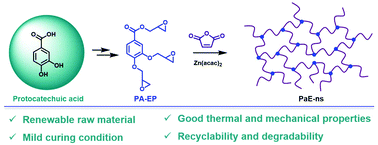Sustainable alternative to bisphenol A epoxy resin: high-performance recyclable epoxy vitrimers derived from protocatechuic acid†
Abstract
Vitrimers have constituted one of the hottest research fields in recent years since they are not only mechanically robust and thermally stable like traditional thermosets but also can be recycled through a physical hot press like thermoplastics. Epoxy vitrimers are the most promising of all vitrimers because they are easy to prepare and durable for long-term service. Aromatic biomass has recently been shown to replace commercial bisphenol A as a raw material for epoxy vitrimers, but it is usually difficult to use it to achieve high performance and reprocessability at the same time. Starting from protocatechuic acid, a series of high-performance epoxy vitrimers with different catalyst loadings and ratios of epoxy/anhydride were prepared. In this work, the new epoxy resins showed much better thermal and mechanical properties (Tg = 157 °C, tensile strength = 65 MPa) than commercial BPA-based epoxy resins. Moreover, these bio-based epoxy vitrimers can also be reprocessed with extremely high efficiency and degraded in NaOH solution. The great properties of epoxy vitrimers derived from protocatechuic acid indicate that they can be used as renewable alternatives to BPA epoxy resins.



 Please wait while we load your content...
Please wait while we load your content...